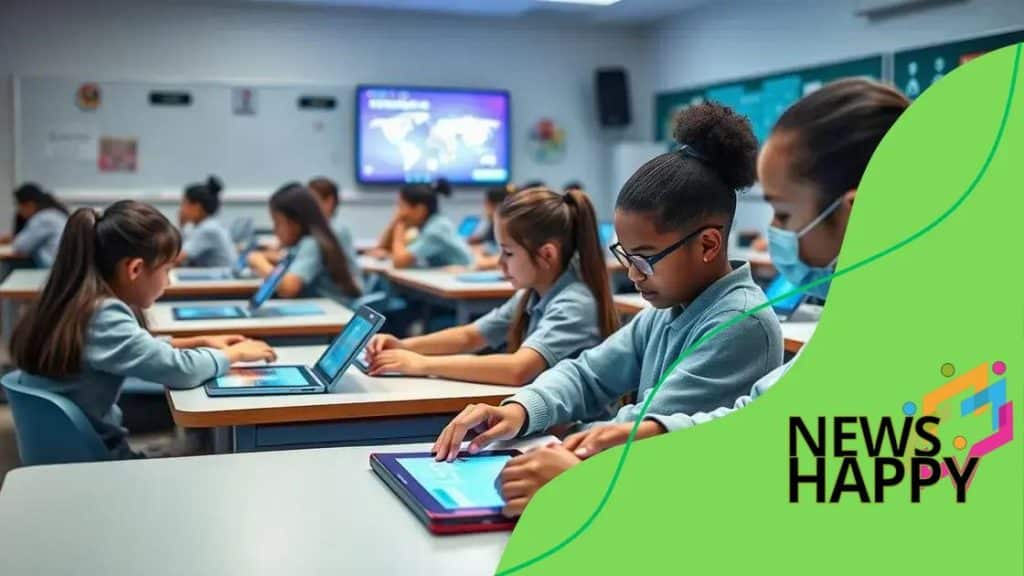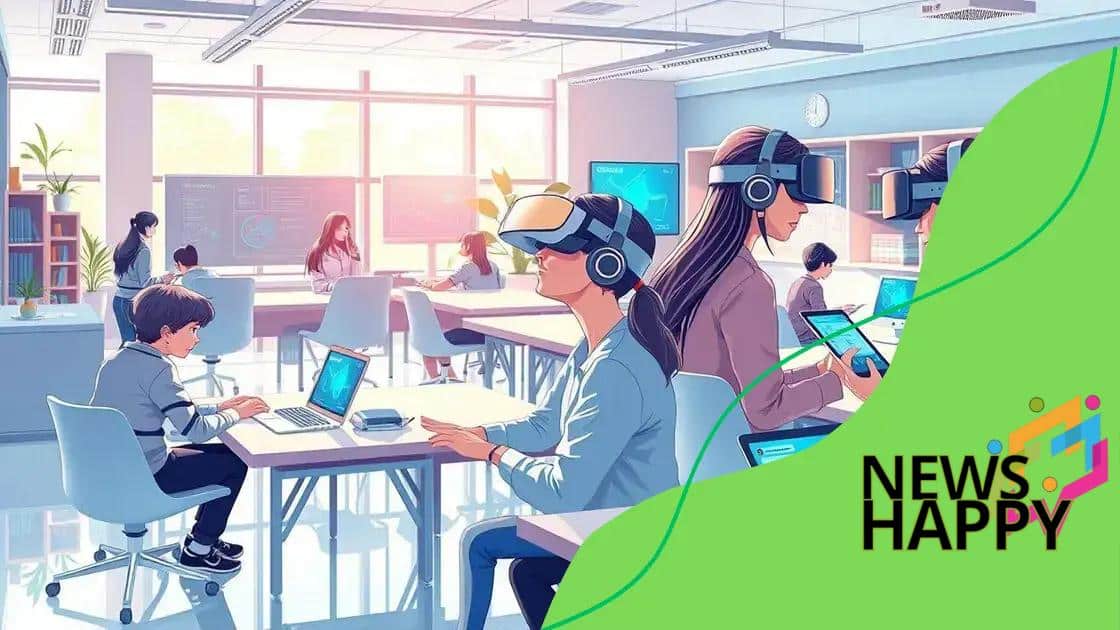The future of personalized learning through AI-powered tools

Anúncios
The future of personalized learning through AI-powered tools transforms education by offering tailored learning experiences, enhancing teacher support, and facilitating global collaboration, while also presenting challenges like infrastructure needs and data privacy concerns.
The future of personalized learning through AI-powered tools is shaping how we approach education today. Have you ever wondered how technology can cater to individual learning styles? Let’s dive into this exciting topic!
Anúncios
Understanding personalized learning and its importance
Understanding personalized learning is vital in today’s educational landscape. It tailors teaching methods to meet each student’s unique needs. This approach can ignite a passion for learning, enabling students to thrive academically.
The core principles of personalized learning
At its heart, personalized learning focuses on the individual. It allows students to learn at their own pace and follow their interests. This flexibility not only enhances understanding but also fosters a love for learning.
- Individualized learning paths
- Incorporating student preferences
- Utilizing technology for real-time feedback
AI-powered tools play a crucial role in this process. They analyze student performance and adapt materials accordingly, ensuring that learners are always challenged yet supported. For example, if a student excels in math but struggles with reading, the AI can adjust resources to help bridge that gap.
Anúncios
Importance of personalized learning
The importance of personalized learning cannot be overstated. It promotes equity in education, giving every student the chance to succeed. When students receive personalized attention, they are more engaged and motivated to learn.
- Boosts student engagement
- Enhances critical thinking skills
- Improves overall academic performance
Moreover, as classrooms become more diverse, a one-size-fits-all approach no longer suffices. Personalized learning recognizes that each student has unique challenges and strengths.
By embracing this model, educators can create more inclusive environments. This not only benefits students but also fosters a sense of community within the classroom. When students feel understood and valued, their commitment to learning grows.
How AI tools enhance the learning experience
AI tools are revolutionizing how students learn and interact with educational content. By providing tailored resources and feedback, these tools make learning more engaging and effective. Imagine a classroom where technology adapts to each student’s needs in real time.
Benefits of AI tools in education
Integrating AI tools into the classroom offers several benefits that can transform the educational experience.
- Personalized feedback can help students improve faster.
- Learning analytics provide insights for teachers on student progress.
- Adaptive learning systems adjust content to match individual skill levels.
For example, platforms using AI can analyze a student’s performance over time. They identify strengths and weaknesses, allowing for a more focused approach. This means students spend less time on topics they already understand and more time on challenging areas.
How AI facilitates interactive learning
Moreover, AI tools encourage interactive learning. With features like virtual simulations and gamified lessons, students can engage in a way that’s both fun and educational. This interactive setup makes complex concepts easier to grasp.
- Virtual reality experiences immerse students in the subject matter.
- Gamification motivates students to achieve learning goals.
- Collaborative tools foster teamwork and communication.
Through these engaging methods, learners are more likely to retain information. Plus, they can explore topics from multiple angles, leading to a deeper understanding. Just think about how a science simulation can bring the laws of physics to life.
AI tools also support teachers by automating administrative tasks. This means educators can focus more on guidance rather than paperwork. With less time spent on grading and scheduling, teachers can engage more with students, fostering a richer educational environment.
Real-life examples of AI in educational settings

Real-life examples of AI in educational settings showcase how technology enhances teaching and learning. Schools and universities are starting to embrace AI, making education more efficient and personalized for students.
AI-powered tutoring systems
One prominent example is AI-powered tutoring systems that assist students outside the classroom. These systems provide personalized learning experiences based on individual student needs.
- Tools like Carnegie Learning offer math tutoring with immediate feedback.
- Platforms such as Squirrel AI adapt learning paths to meet each student’s pace.
- These tools often improve performance significantly, making them a valuable addition to traditional methods.
Additionally, many educational institutions use these systems to supplement classroom instruction. This allows teachers to focus on more complex topics while students get tailored support.
Virtual and augmented reality in classrooms
Another exciting application of AI is the use of virtual and augmented reality in the classroom. These technologies immerse students in interactive learning experiences.
- Platforms like Engage and Labster provide virtual lab experiences for science students.
- History students can explore ancient civilizations through 3D environments.
- Such immersive experiences enhance engagement and retention of knowledge.
Using AI-driven simulations, students can practice real-world skills in a safe environment. For instance, medical students can learn surgical procedures through VR without any risk.
Finally, AI chatbots are being employed on campuses to support students in administrative processes. These bots can answer questions and guide students through enrollment and course selection, saving time for both students and staff.
Challenges in implementing AI-powered learning
Implementing AI-powered learning presents several challenges for educators and institutions alike. While the benefits are immense, the road to integrating AI into the classroom can be bumpy and complex.
Technical limitations
One major challenge is the technical limitations associated with AI tools. Many schools may lack the necessary infrastructure, such as reliable internet access and updated hardware.
- Outdated computers may not support advanced AI applications.
- Poor internet connectivity can affect the performance of cloud-based AI tools.
- Limited tech support can hinder effective implementation.
Without addressing these issues, institutions may struggle to reap the full benefits of AI in education. As a result, a thorough assessment of the existing technology landscape is crucial before adoption.
Training educators
Another significant challenge involves training educators to effectively use AI tools. Many teachers may feel overwhelmed or uncertain about how to integrate such technologies into their teaching methods.
- Professional development programs are needed to build confidence.
- Educators should understand the capabilities and limitations of AI tools.
- Collaboration among teachers can foster shared learning experiences.
When educators receive proper training, they can better utilize AI to enhance their teaching practices, leading to improved student outcomes.
Ethics and data privacy concerns
Lastly, ethical considerations and data privacy concerns cannot be overlooked. The use of AI in education involves collecting and analyzing large amounts of student data.
- Schools must ensure compliance with data protection regulations.
- Transparency is key to maintaining trust among students and parents.
- Establishing clear guidelines on data usage is essential.
As institutions navigate these challenges, it’s essential to prioritize ethical practices while harnessing the power of AI to improve learning experiences.
The potential impact of AI on future education
The potential impact of AI on future education is immense and multifaceted. As technology continues to evolve, AI is set to play a crucial role in reshaping learning environments and experiences.
Personalized learning experiences
One of the most exciting aspects of AI is its ability to offer personalized learning experiences. AI can analyze student data to tailor educational content, helping to meet individual needs.
- Students can learn at their own pace, exploring topics that interest them.
- Adaptive platforms ensure that learners are challenged appropriately based on their skill levels.
- Early interventions can be implemented when students struggle, promoting better outcomes.
This level of customization can lead to higher engagement and motivation among students, ultimately fostering a more positive learning atmosphere.
Enhanced teacher support
Another significant impact of AI is on teacher support. By automating administrative tasks, AI gives educators more time to focus on teaching and student interaction.
- Grading can be streamlined through AI-powered tools.
- Data analytics can provide insights into student performance.
- Teachers can access resources tailored to their specific needs.
This support enables educators to create more dynamic and engaging lessons, benefiting both teachers and students.
Global learning opportunities
AI also has the potential to break down geographical barriers in education. With online platforms and virtual classrooms, students from different parts of the world can connect and collaborate.
- Global classrooms foster diverse perspectives and cultural exchanges.
- Students can access resources and expertise that were once unavailable.
- AI can assist in language translation, making communication easier.
As a result, students can gain a more comprehensive understanding of global issues, preparing them to navigate an increasingly interconnected world.
Overall, the future of education, bolstered by AI, promises to create a more personalized, efficient, and inclusive learning environment. Educators and students alike can look forward to exciting advancements that will transform how knowledge is shared and acquired.
In conclusion, the integration of AI in education presents incredible opportunities for enhancing learning experiences. As we look ahead, personalized learning, teacher support, and global collaboration will likely define the future classroom. Although there are challenges to overcome, the potential benefits of AI in improving student outcomes and making education more inclusive are substantial. Embracing AI tools can create a more engaging, efficient, and equitable learning environment for all students.
FAQ – Frequently Asked Questions about AI in Education
How can AI personalize learning for students?
AI can analyze student data to create customized learning experiences, allowing each student to learn at their own pace.
What support does AI provide to teachers?
AI automates administrative tasks, giving teachers more time to focus on interacting with students and improving lesson plans.
How does AI promote global collaboration in education?
AI connects students from different parts of the world, allowing for shared learning experiences and diverse cultural exchanges.
What challenges do schools face when implementing AI?
Schools often struggle with technical infrastructure, the need for teacher training, and ensuring data privacy and ethical considerations.





